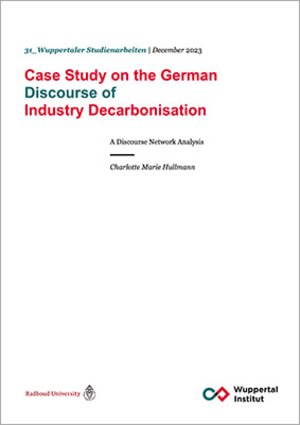
The adoption of the Paris Agreement in 2015 and the passing of the Climate Action Law in Germany in 2019 established the legal need for the basic material industry in Germany to decarbonise. For the industry sector, the target is sets at a 49-51% GHG reduction by 2030 compared to 1990. Even though the sector specific targets are likely to become obsolete, a Hydrogen Strategy, Industry Strategy and Climate Protection Contracts are currently being developed or elaborated on. These are to further ensure and enable the basic material industry in Germany to decarbonise. These developments are emphasising the relevance of studying the industry decarbonisation at the time of conducting this research.
As the institutionalisation of the industry decarbonisation is influenced by discourse, the analysis of the discourse is an important tool for studying the power effects produced by and built into the discourse. This is the first research aiming to provide a structured analysis of the discourse on industry decarbonisation in Germany. Drawing on discourse analysis and the Multilevel-Perspectives framework, this research investigated the power and dominance of storylines to influence the discourse of the industry transformation towards decarbonisation. In this research insights were obtained into the storylines used in this discourse, the actors who are part of this discourse, the frequency of storylines used and the percentage of actors making use of these storylines. Additionally, insights were generated into the discursive network and potential coalitions.
This research made use of the Discourse Network Analysis software in combination with Visone and Excel for data collection, analysis, and visualisation. Based on 117 documents of various categories from the years 2012 to 2023, the discourse on German industry decarbonisation is discovered to be dominated by storylines of mainly technological or economic nature. The general sentiment discovered by the different actors is positive with the storylines focusing on establishing the conditions for the industry to decarbonise and no resistance being communicated. The discourse is furthermore dominated by most storylines. 18 out of 27 storylines are being used by more than 56% of all actors. The high overlap in storyline indicates discursive homogeneity. The homogeneity is further indicated through the lack of emerging discourse coalitions and the therewith connected lack of struggles for discursive dominance. One coalition can be defined with some actors being deeper involved and some being less involved in the discourse.
As decisions on the transition path for Germany's industry to decarbonise are still to be taken the lack of discursive struggles has come to my surprise. In the discussion I reflect on how the positive sentiment, the discursive homogeneity and the great number of dominant storylines may come about.
Charlotte Marie Hullmann:
Case Study on the German Discourse of Industry Decarbonisation
A Discourse Network Analysis
Wuppertal 2023, ISBN 978-3-946356-34-9
(Wuppertaler Studienarbeiten zur nachhaltigen Entwicklung no. 31)
